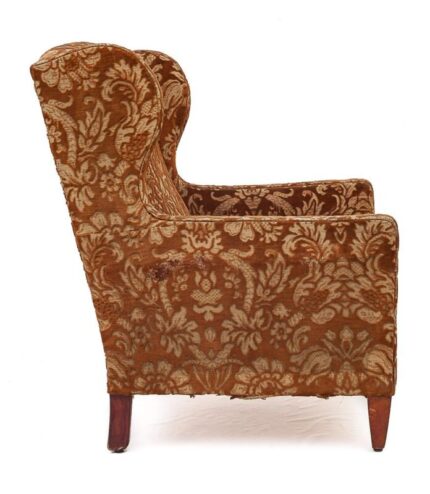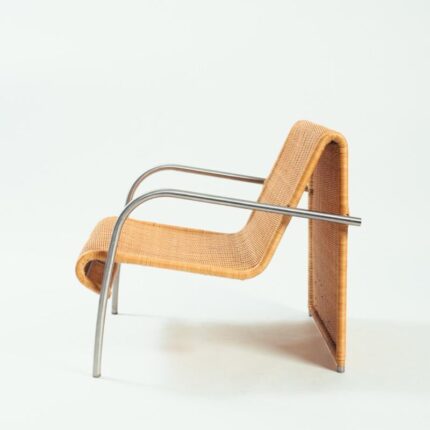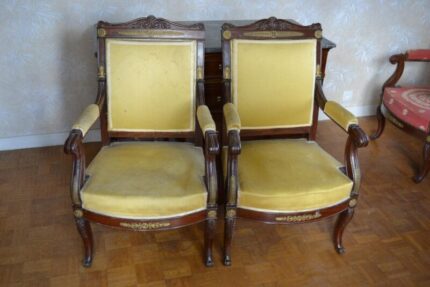John Bennett (1840–1907)
Earthenware, painted and glazed
4 in. high, 7 5/8 in. diameter
Signed, dated, and inscribed (on the bottom): J B[monogram]ENNETT / N.Y. / 1882 / R
If the Herter Brothers was the most distinguished and successful cabinetmaking and decorating firm working in New York in the 1870s and 1880s, the transplanted Englishman John Bennett was probably the most gifted ceramicist working in New York in the Aesthetic Period. (Bennett was included in The Metropolitan Museum of Art’s landmark exhibition, In Pursuit of Beauty – Americans and the Aesthetic Movement, in 1986-87, and Ms. Alice Cooney Frelinghuysen’s chapter, “Aesthetic Forms in Ceramics and Glass,” pp. 216-19, significantly informs this essay). Born in England, the son of a potter who worked in the Staffordshire district, Bennett came under the influence of John Sparkes, head of London’s Lambeth School of Art. Soon thereafter, he was hired by Henry Doulton of the eponymous firm to teach artisans there the new art of underglaze faience decoration, which was part of a revival of the sixteenth-century interest in hand-painted ceramics.
A number of Bennett’s work’s for Doulton were shown in the Doulton display at the Centennial Exposition in Philadelphia in 1876, and the considerable success enjoyed by Bennett and Doulton from an American audience undoubtedly played an important role in Bennett’s decision to leave Doulton and England and set up shop in New York in 1877. By the next year, he had already established a studio in New York, where he produced his own pottery in the tradition of the Arts & Crafts innovators, William Morris and William de Morgan, and also taught classes at the new Society of Decorative Art to the growing band of women who had taken up china painting–both professionally and avocationally.
Bennett’s pottery developed a very serious following among students and collectors, and was offered for sale at such leading retail establishments as Tiffany & Company in New York. Typically, as with the present example, his work was brilliantly colored, with carefully drawn naturalistic flowers against a monochromatic background. In this example, he shows dogwood blossoms against a bold cadmium yellow background.
Bennett’s fully-developed American work is exceedingly rare, as he worked in New York only from 1877 to 1883, in which year he withdrew to a farm in rural West Orange, New Jersey, where his production continued on a limited basis. He remained listed as a ceramicist there until 1889. Although we do not know whether Bennett worked out of this 24th Street studio from the outset, he was indeed working there by 1879 when he made (and signed, inscribed, and dated) a charger with white and red flowers now in the collection of the Art Institute of Chicago, which specifically points to “412 East 24 / NY” (acc. no. 1998.317). Additionally, the U.S. Census of 1880 lists Bennett as a ceramicist located at that same address, married to Mary Bennett, by whom he had had six children.
The present bowl is signed by Bennett, inscribed New York, and dated 1882, which places it toward the end of his New York years. Other works by Bennett from this particular time period include an example from 1882 at the Houston Museum of Fine Arts, Texas (formerly collection of Hirschl & Adler Galleries, FAPG 20113D; photograph in Hirschl & Adler archives), with white dogwood against a cadmium yellow ground; a similar one also from 1882 with pink and white dogwood against a cadmium yellow ground in the collection of the Metropolitan Museum of Art, New York (acc. no.1984.425; see Frelinghuysen p. 219 fig. 7.21); a vase with pink hibiscus flowers against a blue ground from 1889, at the Detroit Institute of Arts (formerly collection of Hirschl & Adler Galleries, FAPG 19453D; photograph in H &A archives); and a large vase, made in 1882, with pink peonies on a bright blue ground (see Alice Cooney Frelinghuysen, Martin Eidelberg, and Adrienne Spinozzi, American Art Pottery—The Robert A. Ellison, Jr. Collection (New York: The Metropolitan Museum of Art, 2018), p. 40 Fig. 26), which is a gift to the Metropolitan Museum of Art, New York, from Robert A. Ellison, Jr. (acc. no. 2009.22.50; see Antiques & Fine Art (Early Summer 2009), p. 147 fig. 2 illus. in color).
CONDITION: Excellent, except for one small chip to the unglazed portion of the underside.
-
Creator:John Bennett(Maker)
-
Dimensions:Height: 4 in (10.16 cm)Width: 7.63 in (19.39 cm)Depth: 7.63 in (19.39 cm)
-
Style:Aesthetic Movement(Of the Period)
-
Materials and Techniques:EarthenwareGlazed
-
Place of Origin:United States
-
Period:19th Century
-
Date of Manufacture:1882
-
Condition:ExcellentWear consistent with age and use. Excellent, except for one small chip to the unglazed portion of the underside.
-
Seller Location:New York, NY
-
Reference Number:Seller: FAPG 20444DSeller: LU903213587022





























Reviews
There are no reviews yet.